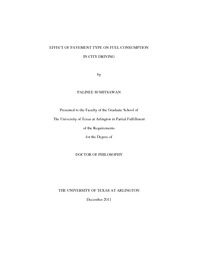
ATTENTION: The works hosted here are being migrated to a new repository that will consolidate resources, improve discoverability, and better show UTA's research impact on the global community. We will update authors as the migration progresses. Please see MavMatrix for more information.
Show simple item record
| dc.contributor.author | Sumitsawan, Palinee | en_US |
| dc.date.accessioned | 2012-04-11T20:59:31Z | |
| dc.date.available | 2012-04-11T20:59:31Z | |
| dc.date.issued | 2012-04-11 | |
| dc.date.submitted | January 2011 | en_US |
| dc.identifier.other | DISS-11396 | en_US |
| dc.identifier.uri | http://hdl.handle.net/10106/9641 | |
| dc.description.abstract | Vehicular fuel consumption and emissions are two increasingly important measures of effectiveness of sustainable transportation systems, particularly considering that mobile sources in the U.S. account for the largest consumption of energy and generation of air pollution. Improving the energy efficiency of the transportation sector including improving vehicle shape, weight, engine size, and tire quality could play a vital role in reducing fuel consumption and exhaust gas emissions. Pavement surface type and other surface characteristics such as skid resistance and roughness affect vehicular fuel consumption. The main objective of this study has been to investigate any differences that might exist in fuel consumption when operating an instrumented van on an Asphalt Concrete (AC) versus on a Portland Cement Concrete (PCC) pavement under city driving conditions. The overall study goal has been to recommend consideration of such user costs or savings in the life cycle analysis of alternative pavement designs for city streets. Fuel consumption measurements were made on multiple runs under two driving modes: 30-mph constant speed and 3-mph/sec acceleration for 10 seconds. All factors that could affect fuel consumption, other than the pavement surface were either controlled or kept the same during the measurement runs. Those factors included speed, ambient temperature, relative humidity, wind speed and direction, vehicle weight, tire pressure, and use of auxiliary devices in the vehicle. The results indicated that the differences in fuel consumption rates were statistically significant at a 10% level of significance under both constant speed and acceleration modes, with the fuel consumption rates on the PCC pavements being lower. The extrapolated results also indicated that if all the annual vehicle miles of travel in the Dallas-Fort Worth region took place at a constant speed of 30 mph on PCC pavements, the statistically lower fuel rates could result in an annual savings of about 401 million gallons of fuel and an annual CO2 reduction of about 3.53 million metric tons. Using an average gasoline price of about $3.29 per gallon and an average CO2 clean-up cost of about $18 per metric ton, these differences would amount to a savings of about $1.38 billion per annum in the DFW region. The potential savings or costs in fuel consumed and the CO2 emissions generated can be substantial over the design life of a road project. It is therefore recommended that these savings or costs be considered in the life cycle cost analysis of alternative road construction projects. | en_US |
| dc.description.sponsorship | Ardekani, Siamak | en_US |
| dc.language.iso | en | en_US |
| dc.publisher | Civil & Environmental Engineering | en_US |
| dc.title | Effect Of Pavement Type On Fuel Consumption In City Driving | en_US |
| dc.type | Ph.D. | en_US |
| dc.contributor.committeeChair | Ardekani, Siamak A. | en_US |
| dc.degree.department | Civil & Environmental Engineering | en_US |
| dc.degree.discipline | Civil & Environmental Engineering | en_US |
| dc.degree.grantor | University of Texas at Arlington | en_US |
| dc.degree.level | doctoral | en_US |
| dc.degree.name | Ph.D. | en_US |
Files in this item
- Name:
- Sumitsawan_uta_2502D_11396.pdf
- Size:
- 2.499Mb
- Format:
- PDF
This item appears in the following Collection(s)
Show simple item record


